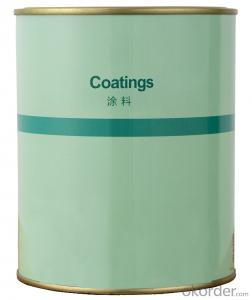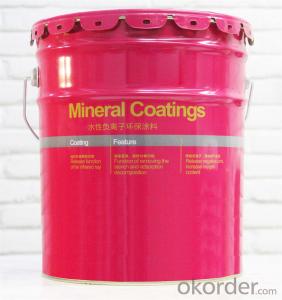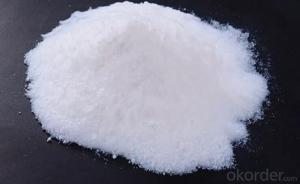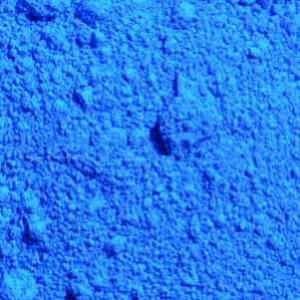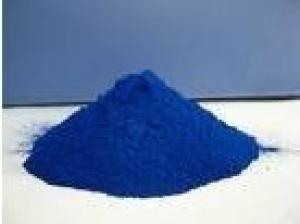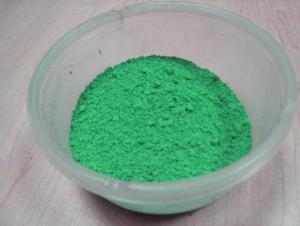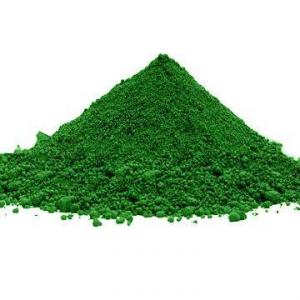Iron Oxide Orange Pigment 960 from China
- Loading Port:
- China main port
- Payment Terms:
- TT OR LC
- Min Order Qty:
- 100000 kg
- Supply Capability:
- 1000000 kg/month
OKorder Service Pledge
OKorder Financial Service
You Might Also Like
Quick Details
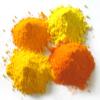
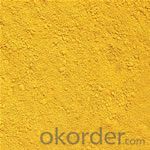
Other Names: ferric oxide orange
MF: Fe2O3
Place of Origin: China (Mainland)Usage: Ceramic Pigments, Coating Pigment, Cosmetic Pigment, Ink Pigments, Plastic & Rubber Pigment, Leather Pigments, paint and coating
Model Number: 960
Type: Iron Oxide
product: iron oxide orange pigment 960
appearance: yellow powder
1 iron oxide yellow powder Specifications
2 good covering ability and weather resistance
3 fine dispersion
4.20years factory
Specifications:
Item | Index |
Primary color | |
Diluted color | |
Iron content (Fe2O3) 105℃ drying%≥ | 86 |
Fineness (325 mesh wet sieve residue)%≤ | 0.3 |
Oil absorption, g/100g | 25-36 |
Moisture & 105℃ volatile% | 1.5 |
Water solubles% ≤ | 0.5 |
Water suspended matter PH value | 4-6 |
Relative tinting strength (compared with standard sample%) ≥ | 100±5 |
4. Packing:
Net weight 25 kg in craft paper bag or knitting bag with plastic liner or as per clients' request. 13 MT/20'FCL
FAQ:
1.Q:Are you a manufactory or trading company?
A:We are a professional manufactory with 12 years’ experience and 2 years of export experience, covers an area of 30 acres.
2.Q: May I know your MOQ request?
A:MOQ is 1 TON.
3.Q: Could you offer free sample?
A:We can provide free samples to you for quality testing.
4.Q: Does your product is dangerous merchandise?
A: Not dangerous merchandise, It belongs to Not legal Inspection merchandise.
- Q:Can you take any powder, grind it finely, and mix linseed oil into it to make oil paints to make paint? Or do paint pigments have to have special characteristics? Thanks!!
- There are distinct forms of eyeshadows, that means distinct finishes. Matte, for instance, shall be very, very focused within the colour, wherein as a lustre will exhibit up sheer, and you can barley get any precise pigment out of it. MAC paint is for a base, or primer to your eye lids, that means you might placed that on BEFORE you place any eye liner, shadow, pigment, and so on. Depending at the colour paint you utilize, it would increase or tone down and eye shadow or pigment then you definitely situation at the lid. Pigment is an excessively, very focused free powder. You best want a tiny, tiny pinch of it, and the boxes they arrive in, move a verrrry good distance. The intent individuals mostly use pigments as a shadow replacement, might be for the reason that both MAC does now not bring the precise colour of the paticular pigment in a shadow, or they are utilising it to increase shadows, or finally, they are blending it with shadows to create distinct colours. Hope this is helping.
- Q:We see pigments everywhere in products. They make a variety of things we see today. Where does it come from? Do they actually take a red rose pedal, grind the color and designate it as the color red?
- Yes, cheaper brands use actual dye. Like, literally dye, as in the stuff you can dye clothing with.
- Q:i want to get mac melon pigment but i dont know what other eyeshadows to pair and blend it with. im looking for an everyday look. also what brushes to use with pigments?
- With the Melon pigment, I would recommend using warm, chocolate copper, bronze types of colors. It will provide a nice contrast to the melon while giving your eyes some added depth and definition. As far as brushes go, I like using the 252, large shader brush. This brush picks up pigment nicely and it has nice compressed/dense bristles so you can manipulate and lay the pigment down with greater ease. I like the #286 The dual fiber blending brush for pigments as well. It's made of natural fiber and synthetic fiber. This is a great brush because you really get 2 brushes in 1. With this 'blending' brush you can also use it for targeted color deposits and the synthetic fibers won't suck up what you just laid down and you will get a flawless, beautifully blended eyeshadow application.
- Q:i would like to now so i could put it in a marker thanks..
- Isn't all ink pigmented? A quick search for make your own ink turned up many recipes. Here is one: Basic Permanent Black Ink: 1 egg yolk 1 tsp gum arabic 1/2 cup honey 1/2 tsp lamp black (buy in a tube or make by holding a plate over a lit candle) Mix egg yolk, gum arabic and honey in a small bowl.
- Q:do all leaves extract contain the same pigments??why?
- Absolutely not. Leaf pigments, just to name a few, may include chlorophyll, carotenes, lutein, anthocyanins. Not only will pigment content vary between plant species, but pigment content will vary in individual plants seasonally.
- Q:ive been watching a lot of makeup videos on youtube and a lot of the girls use mac pigments. what exactly are they and how are they different from regular eyeshadow? are they easier or more difficult to use?
- they are a loose powder like consistency, and they're just that.. they're super pigmented!!! ut i have about 26 pigments (: most are mac, some other brands.
- Q:Does anyone know of a way to change the color of your iris' permanently?I've been researching for a while, and have not been able to find anything! I already know about newcoloriris (surgery), but that had loads of side effects. I already know about contacts (ive had them on and off for a while).I don't see how with all the science and technology in the world, there's no way to simply lighten your eye color. We can literally dye our skin, we can tattoo our eyeballs, we can do almost ANYTHING in the world today. So, how has nobody discovered a way to change eye color.?I'm aware that blue/light eyes are a result of low melanin production, But i don't understand how there's no known way to reduce the overproduction of melanin in darker/brown eyed people.It's really frustrating. If anyone knows any websites, doctors, or scientists currently working on a way to do this, please let me know! Or if you know of a new way someone has come up with, please let me know!lt;3 THANKSSSS
- Whatever you decide to do...just remember that you ONLY have two eyes, you mess up with your vision and the consequences are not good..you can seriously hurt your vision and even become blind for life.. Just be happy with what you have and wear contacts to change your eye colour.
- Q:which do you think is better??? and how do you apply pigment??? my boyfriend gave me a bag full of MAC make up in which there are 2 pigment bottles... i already love their eyeshadow.. i just want people's opinion on which one is better and when to use pigment... i mean, what is the difference??? Help Please!
- Pigment gives a stronger color. You can apply it normally like shadow with a brush or put water on the brush and apply it to intensify the color. I like pigment for a night time look and shadow in the evening.
- Q:I need to find powdered paint or pigment that I can throw, for some photographs.Preferably cheap, and that wouldn't stain skin.I've looked into powder paint, though this tends to stain skin for about a week.Thanks :)
- There are diverse varieties of eyeshadows, which means diverse finishes. Matte, working example, would be very, very centred interior the colour, wherein as a lustre will reveal up sheer, and additionally you will possibly be able to barley get any precise pigment out of it. MAC paint is for a base, or primer on your eye lids, which means you will possibly be able to placed that on until now you place any eye liner, shadow, pigment, etc. based on the colour paint you make the main of, it would strengthen or tone down and eye shadow or pigment then you definately definately challenge on the lid. Pigment is a very, very centred loose powder. You superb want a tiny, tiny pinch of it, and the containers they arrive in, circulate a verrrry sturdy distance. The purpose persons customarily use pigments as a shadow alternative, may be in view that the the two MAC does now not deliver the precise colour of the paticular pigment in a shadow, or they are applying it to extend shadows, or finally, they are mixing it with shadows to create diverse colors. desire that's assisting.
- Q:I bought the color Frozen White, and the store sample was sort chunky too, and it doesn't go on my skin well because of that. How can I apply it on smoothly? do I need to add a little water??? help!!!!
- Some pigments are just designed to be chunky. As the answer above said, definitely use fix+ or mixing mediums. water will not be good enough as it does not have that 'sticky' residue that both fix+ and mixing mediums have. Also, I find that having an eyeshadow base helps a lot - makes pigments a tad easier to blend. This may work or it may not, really depends on the individual pigment, and i've never used Frozen White before... BUT try breaking up the pigment chunks by using a plastic spatula (should be able to buy them in make up stores like Sephora). Literally, put some on the cap and then just crush it until it becomes finer. Hope this helps :)
1. Manufacturer Overview |
|
|---|---|
| Location | |
| Year Established | |
| Annual Output Value | |
| Main Markets | |
| Company Certifications | |
2. Manufacturer Certificates |
|
|---|---|
| a) Certification Name | |
| Range | |
| Reference | |
| Validity Period | |
3. Manufacturer Capability |
|
|---|---|
| a)Trade Capacity | |
| Nearest Port | |
| Export Percentage | |
| No.of Employees in Trade Department | |
| Language Spoken: | |
| b)Factory Information | |
| Factory Size: | |
| No. of Production Lines | |
| Contract Manufacturing | |
| Product Price Range | |
Send your message to us
Iron Oxide Orange Pigment 960 from China
- Loading Port:
- China main port
- Payment Terms:
- TT OR LC
- Min Order Qty:
- 100000 kg
- Supply Capability:
- 1000000 kg/month
OKorder Service Pledge
OKorder Financial Service
Similar products
New products
Hot products
Related keywords













